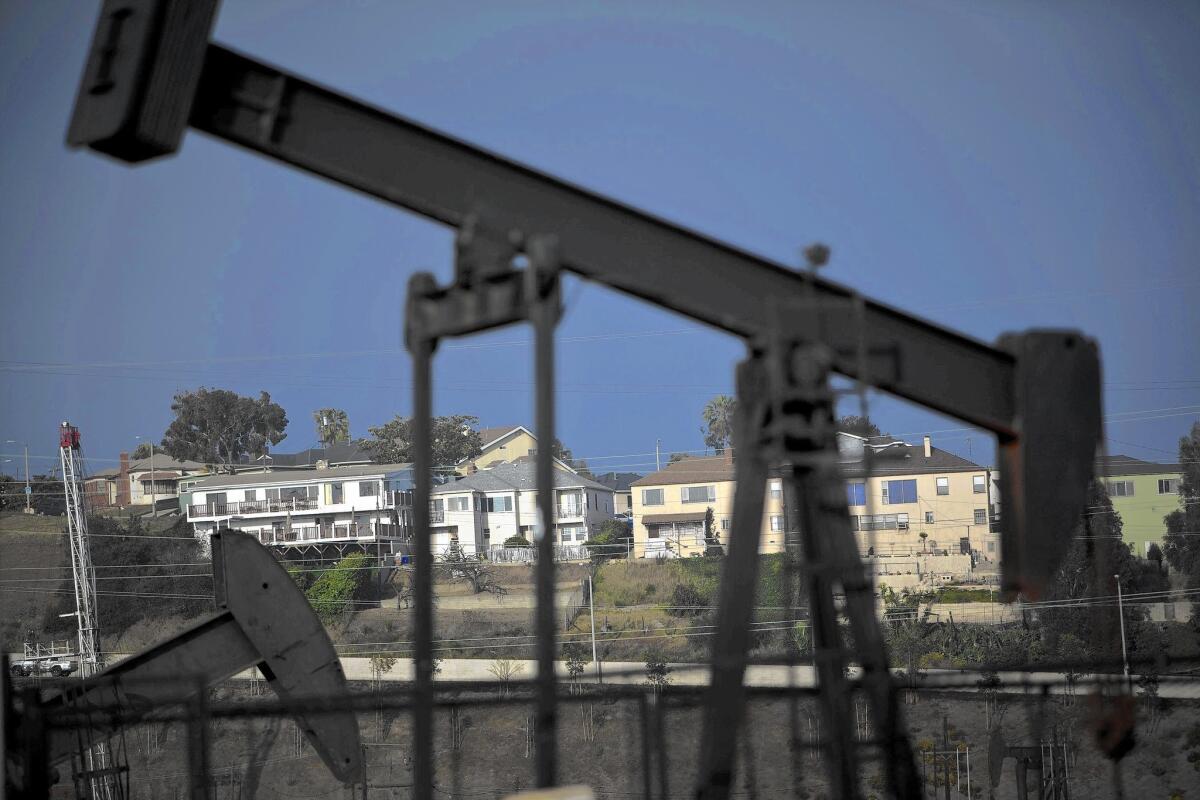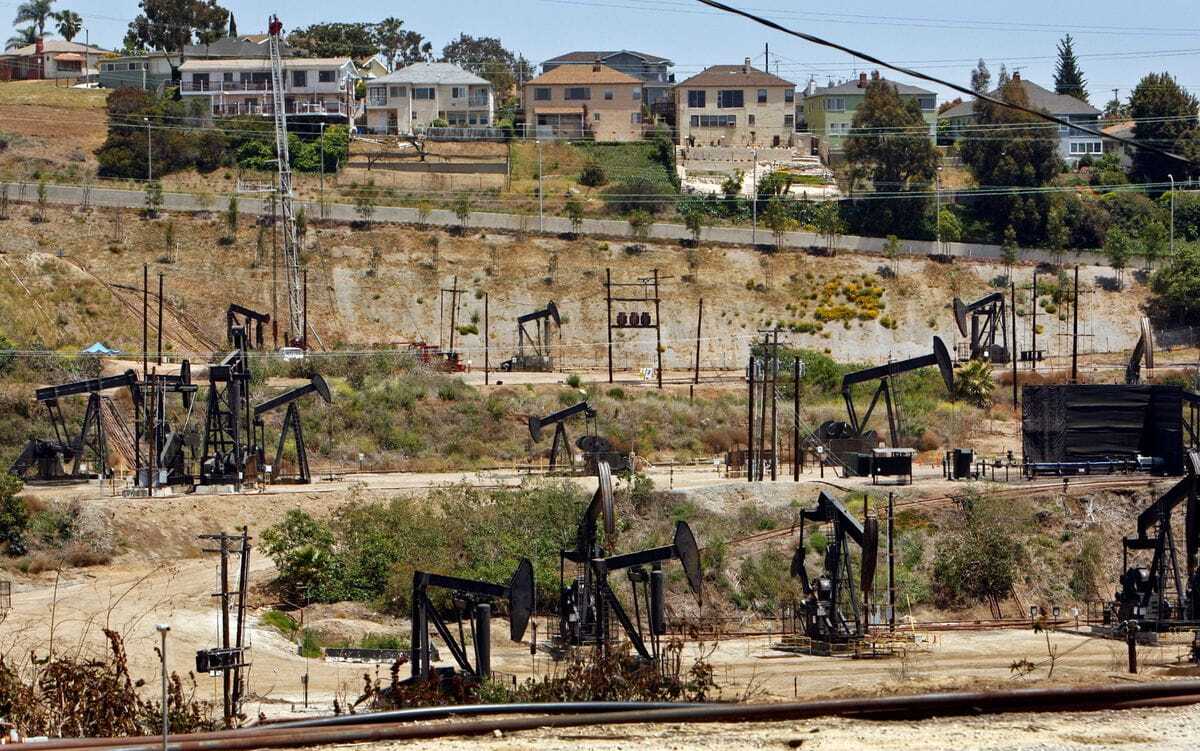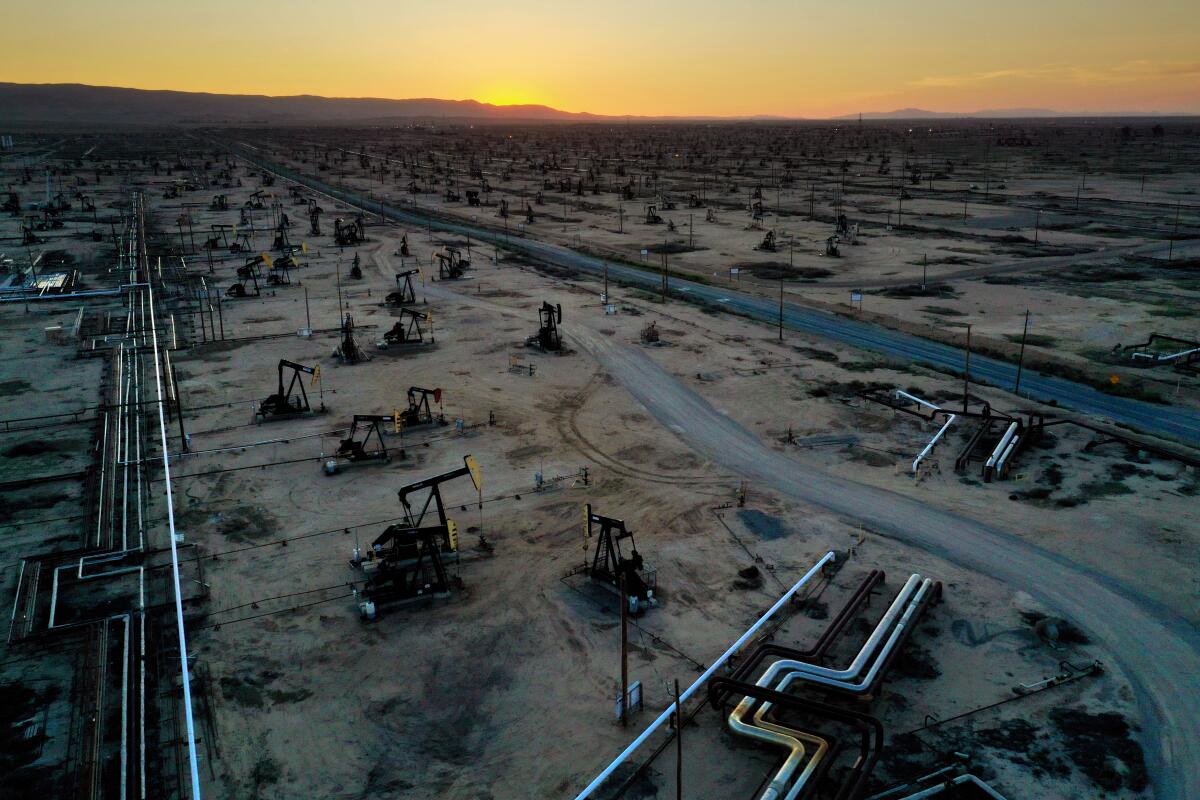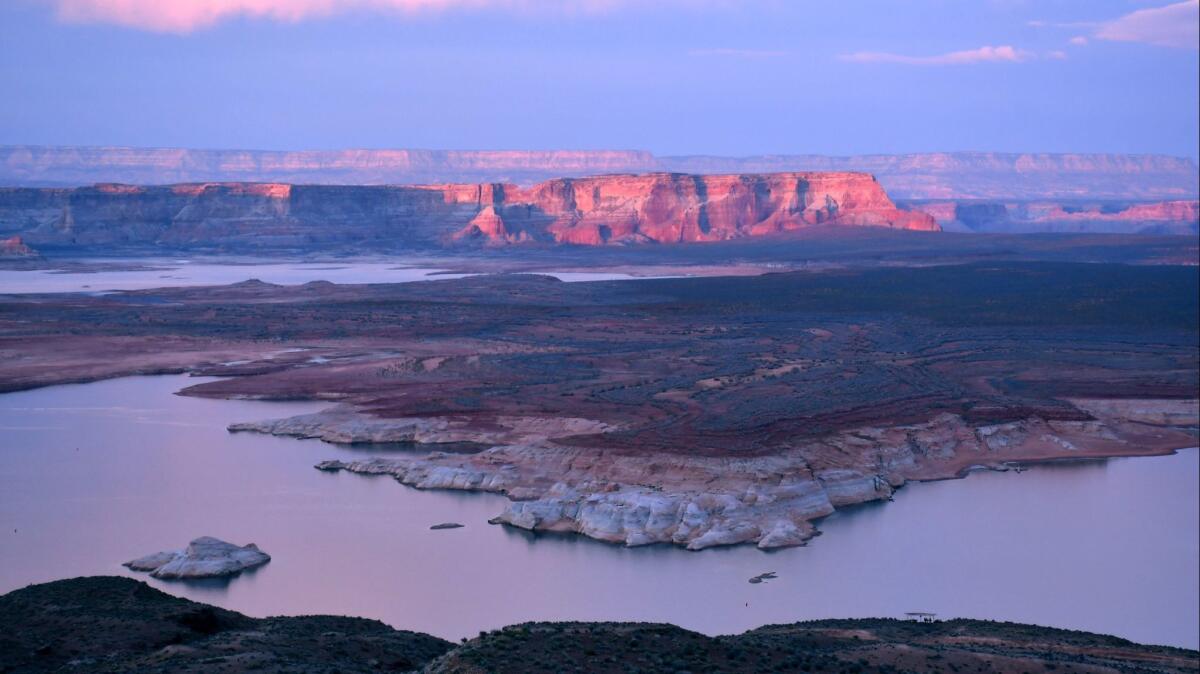How to shut down urban oil drilling? This city has an unusual idea

I don’t think about this too often, but I live near an oil field.
Not so close that I’m really worried about air pollution affecting my health, especially when I live even closer to two major freeways. But I drive past the Inglewood Oil Field all the time — or I did, before the coronavirus came to town. The nearest active well is about a mile and a half from my apartment on the Westside of Los Angeles, as the crow flies, in neighboring Culver City.
So I paid a little extra attention when I learned Culver City is considering a plan to shut down its portion of the oil field. The city released a report last month concluding it may have the authority to close wells within city limit this year.
There are homes right up to the edge of the field, which was first tapped by Standard Oil in the 1920s. Here’s an image captured by Times photographer Al Seib, showing houses in the View Park-Windsor Hills neighborhood with an up-close view of pumpjacks:

Before digging any deeper into Inglewood, let’s stop and remember the theme of last week’s newsletter: environmental injustice. Fossil fuel extraction creates all sorts of environmental injustice issues. People of color are far more likely to breathe air polluted by oil and gas operations, as a result of the same discriminatory systems that gave rise to the Black Lives Matter movement.
Toward a more sustainable California
Get Boiling Point, our newsletter exploring climate change, energy and the environment, and become part of the conversation — and the solution.
You may occasionally receive promotional content from the Los Angeles Times.
It’s also important to note that COVID-19 hasn’t stopped government officials from approving new oil and gas projects.
I’m not just talking about the Trump administration.
In California, regulators working for Gov. Gavin Newsom approved 12 permits last week for hydraulic fracturing — the controversial oil and gas drilling technique better known as fracking — in Kern County, north of Los Angeles. The state’s oil and gas regulator, CalGEM, determined no new environmental review was needed beyond a blanket environmental impact report from 2015 — which, it turns out, was thrown out by a state appeals court earlier this year.
Nonprofit environmental groups say those permits — and two dozen previously issued in April — are illegal under the court order.
State officials disagree, pointing to a modified footnote in the court decision that they say allows them to keep authorizing fracking operations that were already approved by Kern County before the ruling.
As for public health, safety and the environment, a Department of Conservation spokeswoman told me the fracking permits were subject to “rigorous evaluation” and found to meet regulatory criteria by independent scientists at Lawrence Livermore National Laboratory, who were asked by Newsom last year to review CalGEM’s permitting process.
That explanation didn’t satisfy Alex Nagy, California director of the environmental advocacy group Food and Water Watch. She noted that Kern County already suffers from some of the country’s worst air pollution. And its population is majority Latino.
The Newsom administration, Nagy said, “isn’t showing up for racial justice.”

Another battle is playing out in Santa Barbara County, where California’s state water board is considering a request to exempt oil drilling from the Safe Drinking Water Act. If approved by state and federal officials, the exemption could help pave the way companies to drill “steam injection” wells in the Cat Canyon Oil Field.
Environmentalists worry an exemption would add to the risk of oil and gas pollutants seeping into the local aquifer, which provides clean drinking and irrigation water to homes and farms.
“This is not your conventional oil extraction by any means,” said Tara Messing, an attorney at the Environmental Defense Center, which is representing opponents of the Cat Canyon exemption. “It’s extremely risky, extremely carbon intensive.”
I reached out to state board spokesman George Kostyrko, who told me staffers “conducted a thorough technical evaluation” and reached a preliminary conclusion — not yet finalized — that the proposed exemption meets state and federal standards to protect groundwater.
CalGEM, which is also involved, says on its website that Cat Canyon has “natural containment barriers — hundreds of feet of impermeable rock — separating it from other geologic zones that may contain water suitable for drinking or irrigation.”
OK, now let’s get back to the Inglewood Oil Field.
Culver City is studying whether to shut down its portion of the oil field through a process called amortization, in which a local government can require a company to cease economic activity that no longer complies with zoning codes — but only after allowing the company to recoup its investment. Alex Fisch, an environmental lawyer and one of two Culver City council members spearheading the study effort, told me amortization is typically used to remove billboards, making this application fairly unique.
There’s an environmental justice aspect, too.
While Culver City’s population is majority white and relatively wealthy, Fisch said one of the two neighborhoods most affected by the oil field is Blair Hills, home to a much higher percentage of Black families than the city as a whole. And outside Culver City, many of the communities surrounding the oil field are predominantly Black.
Fisch pointed to research linking fossil fuel extraction to health issues for nearby residents. Just last week, UC Berkeley researchers published a study finding that pregnant women living near oil and gas wells in rural California are more likely to have low birth weight babies. (Rachel Becker wrote about the study for CalMatters, with the striking headline, “Oil and babies don’t mix.”)
“Public health has to be front and center,” Fisch said. “And in this case, a dense city has grown up around a 100-year-old extractive industry. And it’s just not safe for residents.”
Idle wells are another concern. Earlier this year, The Times and the Center for Public Integrity published an investigation by Mark Olalde and Ryan Menezes finding that across California, companies “are leaving thousands of oil and gas wells unplugged and idle, potentially threatening the health of people living nearby and handing taxpayers a multibillion-dollar bill for the environmental cleanup.” You can find out how close you live to an active or idle well by searching this map Ryan and Mark created.
I asked a spokeswoman for Sentinel Peak Resources, which owns the Inglewood field, to comment on the possibility of Culver City shuttering wells. She referred me to the California Independent Petroleum Assn., whose CEO, Rock Zierman, said the city “is facing a massive budget shortfall due to the economic fallout of COVID-19. Now is not the time to jeopardize the hundreds of thousands of dollars the Inglewood Oil Field pays in taxes and fees to fund critical local programs, such as schools and firefighters.”
“There are also questions about whether this plan would expose the city to expensive litigation,” he said in a written statement.
Less than 10% of the Inglewood Oil Field falls within Culver City. But if the city manages to shut down even those few wells — a big if — its efforts could provide an interesting precedent for other urban areas looking to stop fossil fuel extraction.
And now, here’s what else is happening around the West:
TOP STORIES
SoCalGas is ramping up use of Aliso Canyon, site of the worst methane leak in U.S. history. Speaking of living near oil and gas infrastructure, residents of L.A.’s Porter Ranch neighborhood are not thrilled that Southern California Gas used the Aliso Canyon storage field a whole lot more last winter, with the blessing of state officials. I wrote about data showing how the gas company’s use of Aliso skyrocketed the last two years, despite Newsom’s stated commitment to shutting down the facility.
There are fantastic sea creatures called giant larvaceans, and their “snot palaces” play an outsize role in fighting climate change. If that sounds too weird to be real, please read this wildly fun story by my colleague Rosanna Xia, who spent time with Monterey Bay Aquarium researchers and learned how this “squishy tadpole-like animal” traps enormous amounts of carbon in an intricate, inflated mucus balloon — still not kidding — and ultimately keeps that carbon out of the atmosphere. Science is cool!
Atmospheric carbon dioxide concentrations reached an all-time high last month. Despite the best efforts of giant larvaceans — and the pandemic-driven economic downturn that has caused emissions to drop slightly — the overall amount of heat-trapping gas in the atmosphere continues its dangerous rise. Scientists reported that carbon dioxide concentrations averaged a record 417.2 parts per million in May 2020, as Bob Berwyn writes for InsideClimate News. Science can also be very, very scary.
ENVIRONMENTAL INJUSTICE
California is one of the wealthiest states, but many Central Valley communities don’t have reliably clean drinking water. Writing for the Fresno Bee, Austin R. Ramsey profiles one of these communities, Tooleville, whose population — like many areas without clean drinking water — is overwhelmingly Latino. Ramsey also explains why state officials rarely force municipal water providers to help out rural areas that rely on contaminated groundwater, even when state officials have the authority to do so.
The Trump administration keeps rolling back environmental protections, often in ways that could disproportionately harm people of color. This week, the Environmental Protection Agency limited the benefits that can be considered when evaluating proposed air-quality regulations, per Bloomberg’s Jennifer A. Dlouhy and Amena Saiyid. Separately, President Trump signed an executive order waiving environmental reviews for oil and gas pipelines, as Marianne Lavelle reports for InsideClimate News.
Transitioning to 90% clean electricity by 2035? It’s not only technically feasible, according to new research from UC Berkeley and the nonprofit consulting group GridLab, but it would actually reduce energy costs. Here’s the story from Julian Spector at Greentech Media. The results are a reminder that the energy transition depends on political will as much as it does economics.
Enjoying this newsletter? Consider subscribing to The Times
Your support helps us deliver the news that matters most, and makes newsletters like Boiling Point possible. Become a Los Angeles Times subscriber.
POLITICAL CLIMATE
There’s been another complication for California’s bullet train. Ralph Vartabedian reports for The Times that a majority of the state Assembly has co-sponsored a resolution directing the High-Speed Rail Authority to hold off awarding a contract to build the first stretch of the system between Bakersfield and Merced. Some lawmakers aren’t happy with Newsom’s plan to start building the bullet train in the Central Valley, and would rather see dollars directed toward Southern California and the Bay Area.
Congress might approve billions of dollars for public lands. It’s looking increasingly likely the GOP-controlled Senate will pass the Great American Outdoors Act, which would fully fund the Land and Water Conservation Fund and allocate $9.5 billion toward the National Park Service’s maintenance backlog. Conservationists are thrilled. Of course, there are politics at play; two Republican senators from western states hope the bill will help them keep their jobs in November, as the New York Times’ Carl Hulse reports.
What do you want to know?
When you think about California’s climate future, what comes to mind? What keeps you up at night, and what gives you hope or gets you excited? What do you want to understand, and what should I?
This newsletter is for you, to help you understand how we’re changing our world and what we can do about it, and I want to hear your questions, concerns and ideas. Email me or find me on Twitter.
AROUND THE WEST
The border wall threatens decades of binational wildlife conservation. That’s the headline on this story by Sarah Tory for High Country News, which explores efforts to protect wildlife corridors that connect the United States and Mexico. The piece features beautiful photos by Michael Berman of newly restored wetlands along that could be severed by Trump’s border wall.

The Southern Paiute tribe is warning that a pipeline to bring Colorado River water to southwestern Utah, 140 miles away, would “make the river angry.” Here’s the story from Brian Maffly at the Salt Lake Tribune, who writes about the wide range of reactions to the federal government’s long-awaited environmental analysis for the proposed Lake Powell pipeline. The Colorado River provides drinking water to 40 million people across the West, including in California, and it’s already over-allocated.
Invasive species are a serious problem across the West, but the conflicts they cause can also be kind of hilarious. I know that sounds weird, but read this amazing story by Michael Booth for the Colorado Sun and tell me you don’t agree. The piece dramatizes the history of westerners doing kooky stuff like importing invasive tamarisk trees, bringing in invasive beetles to control the invasive tamarisks, and then getting into convoluted legal fights over the ripple effects on beloved songbirds.
ONE MORE THING
Like many a desert hiker, I’ve had a few encounters with rattlesnakes that were too close for comfort. Those things are scary.
But gosh darn if I wasn’t tickled to read about new research finding rattlers aren’t the “cold, solitary creatures” we often assume them to be, as Erin Stone writes for the Arizona Republic. Like people, they “prefer to hang out together, rather than be alone.”
That’s right, folks. Rattlesnakes make friends. If they had to shelter in place, they, too, might be lonely.
I’ll be back in your inbox next week. If you enjoyed this newsletter, please consider forwarding it to your friends and colleagues.




